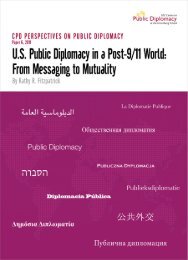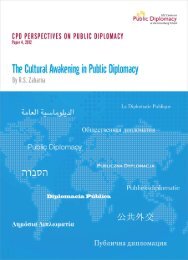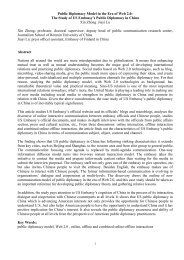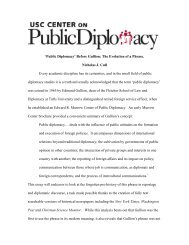Buddhist Diplomacy: History And Status Quo. - USC Center on ...
Buddhist Diplomacy: History And Status Quo. - USC Center on ...
Buddhist Diplomacy: History And Status Quo. - USC Center on ...
- No tags were found...
You also want an ePaper? Increase the reach of your titles
YUMPU automatically turns print PDFs into web optimized ePapers that Google loves.
28 BUDDHIST DIPLOMACY: HISTORY AND STATUS QUOscholars from thirty-seven countries and regi<strong>on</strong>s invited. The forumnaturally did not invite the Dalai Lama. The sec<strong>on</strong>d forum, themed,“A harm<strong>on</strong>ious world; A synergy of c<strong>on</strong>diti<strong>on</strong>s,” brought in 1,700m<strong>on</strong>ks and scholars from over fifty countries and regi<strong>on</strong>s.The Chinese government’s intenti<strong>on</strong> to use these events toshowcase its soft power was clearly articulated by the Panchen Lama,a Tibetan <str<strong>on</strong>g>Buddhist</str<strong>on</strong>g> leader who is believed to have been elevated toa high-profile political role by the Chinese government to help buildinfluence am<strong>on</strong>g the world’s <str<strong>on</strong>g>Buddhist</str<strong>on</strong>g>s as a counterbalance to theDalai Lama. He said, “This event fully dem<strong>on</strong>strates that today’sChina enjoys social harm<strong>on</strong>y, stability and religious freedom. Italso shows China is a nati<strong>on</strong> that safeguards and promotes worldpeace”. 109During the post-Mao era, China first employed Buddhism fordiplomacy with South Korea and Japan in 1995, when <str<strong>on</strong>g>Buddhist</str<strong>on</strong>g>m<strong>on</strong>ks from three countries met for the first time in Beijing. TheChina-South Korea-Japan <str<strong>on</strong>g>Buddhist</str<strong>on</strong>g> Friendly Interacti<strong>on</strong> C<strong>on</strong>ferencehas since been held thirteen times. Senior Chinese religious leadersexpressed hopes that such c<strong>on</strong>ferences should “promote friendshipam<strong>on</strong>g the three countries in generati<strong>on</strong>s to come”. 1102. Joining in pan-Asian initiatives to revive Nalanda UniversityChinese m<strong>on</strong>k Xuan Zang trekked to Nalanda in 627CE andlived there for 13 years to study and teach Buddhism. He broughtback many <str<strong>on</strong>g>Buddhist</str<strong>on</strong>g> texts to China and translated them into Chinese.Since the Indian government initiated the project to revive theancient <str<strong>on</strong>g>Buddhist</str<strong>on</strong>g> propagati<strong>on</strong> center in 2006, China has showedstr<strong>on</strong>g interest in it. In 2006, China d<strong>on</strong>ated US$1 milli<strong>on</strong> to build aChinese studies library for the planned university. 111 Professor WangBangwei of Beijing University was a member of the planning board torevive the university. In a joint declarati<strong>on</strong> by the Indian governmentand the Chinese government, the two agreed to collaborate in thedigitalizati<strong>on</strong> of <str<strong>on</strong>g>Buddhist</str<strong>on</strong>g> manuscripts available in China as well asthe re-development of Nalanda as a major center of learning with the











